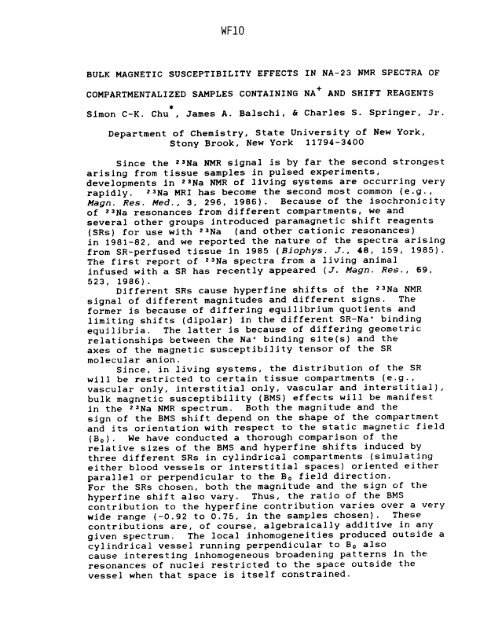th - 1987 - 51st ENC Conference
th - 1987 - 51st ENC Conference
th - 1987 - 51st ENC Conference
Create successful ePaper yourself
Turn your PDF publications into a flip-book with our unique Google optimized e-Paper software.
WFIO<br />
BULK MAGNETIC SUSCEPTIBILITY EFFECTS IN NA-23 NMR SPECTRA OF<br />
COMPARTMENTALIZED SAMPLES CONTAINING NA + AND SHIFT REAGENTS<br />
S<br />
Simon C-K. Chu , James A. Balschi, & Charles S. Springer, Jr.<br />
Department of Chemistry, State University of New York,<br />
Stony Brook, New York 11794-3400<br />
Since <strong>th</strong>e Z3Na NMR signal is by far <strong>th</strong>e second strongest<br />
arising from tissue samples in pulsed experiments,<br />
developments in 23Na NMR of living systems are occurring very<br />
rapidly. 23Na MRI has become <strong>th</strong>e second most common (e.g.,<br />
Magn. Res. Med., 3, 296, 1986). Because of <strong>th</strong>e isochronicJty<br />
of Z3Na resonances from different compartments, we and<br />
several o<strong>th</strong>er groups introduced paramagnetic shift reagents<br />
(SRs) for use wi<strong>th</strong> Z3Na (and o<strong>th</strong>er cationic resonances)<br />
in 1981-82, and we reported <strong>th</strong>e nature of <strong>th</strong>e spectra arising<br />
from SR-perfused tissue in 1985 (BiophFs. J., 48, 159, 1985).<br />
The first report of 23Na spectra from a living animal<br />
infused wl<strong>th</strong> a SR has recently appeared (J. Magn. Res., 69,<br />
523, 1986).<br />
Different SRs cause hyperfine shifts of <strong>th</strong>e Z3Na NMR<br />
signal of different magnitudes and different signs. The<br />
former is because of differing equilibrium quotients and<br />
limiting shifts (dipolar) in <strong>th</strong>e different SR-Na ÷ binding<br />
equilibria. The latter is because of differing geometric<br />
relationships between <strong>th</strong>e Na ÷ binding site(s) and <strong>th</strong>e<br />
axes of <strong>th</strong>e magnetic susceptibility tensor of <strong>th</strong>e SR<br />
molecular anion.<br />
Since, in living systems, <strong>th</strong>e distribution of <strong>th</strong>e SR<br />
will be restricted to certain tissue compartments (e.g.,<br />
vascular only, interstitial only, vascular and interstitial),<br />
bulk magnetic susceptibility (BMS) effects will be manifest<br />
in <strong>th</strong>e 23Na NMR spectrum. Bo<strong>th</strong> <strong>th</strong>e magnitude and <strong>th</strong>e<br />
sign of <strong>th</strong>e BMS shift depend on <strong>th</strong>e shape of <strong>th</strong>e compartment<br />
and its orientation wi<strong>th</strong> respect to <strong>th</strong>e static magnetic field<br />
(B0). We have conducted a <strong>th</strong>orough comparison of <strong>th</strong>e<br />
relative sizes of <strong>th</strong>e BMS and hyperfine shifts induced by<br />
<strong>th</strong>ree different SRs in cylindrical compartments (simulating<br />
ei<strong>th</strong>er blood vessels or interstitial spaces) oriented ei<strong>th</strong>er<br />
parallel or perpendicular to <strong>th</strong>e B0 field direction.<br />
For <strong>th</strong>e SRs chosen, bo<strong>th</strong> <strong>th</strong>e magnitude and <strong>th</strong>e sign of <strong>th</strong>e<br />
hyperfine shift also vary. Thus, <strong>th</strong>e ratio of <strong>th</strong>e BMS<br />
contribution to <strong>th</strong>e hyperfine contribution varies over a very<br />
wide range (-0.92 to 0.75, in <strong>th</strong>e samples chosen). These<br />
contributions are, of course, algebraically additive in any<br />
given spectrum. The local inhomogeneJties produced outside a<br />
cylindrical vessel running perpendicular to B0 also<br />
cause interesting inhomogeneous broadening patterns in <strong>th</strong>e<br />
resonances of nuclei restricted to <strong>th</strong>e space outside <strong>th</strong>e<br />
vessel when <strong>th</strong>at space is itself constrained.













